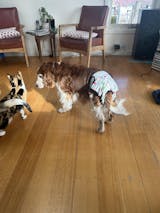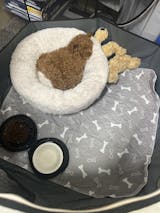Does Pee Pads for Small Dogs Really Work for Housetraining?
With all the fun and excitement that comes with bringing home a new puppy, toilet training might leave you wondering what you were thinking. Pee pads for small dogs (also known as puppy pads or potty pads) are one method for teaching your puppy where to go to the bathroom. Of course, this isn't natural behaviour, so you'll have to teach your puppy to use a pee pad. Consistency is essential in this training method, which you may then utilise to gradually educate your dog to potty outside. In the beginning, potty training your puppy can be challenging, but several tools are at your disposal to help your puppy go where and when you want it to.
Why It's hard Train Small Dogs to Use Pee Pads?
It has been suggested that little dogs are more likely than large dogs to have accidents in the house. Therefore, a puppy training pad can help with consistency, patience, and positive reinforcement while housebreaking your puppy. The idea is to teach positive habits while developing a loving attachment with your pet. A puppy will normally be fully house trained in 4-6 months. However, some puppies may take up to a year.

There are several reasons why little dogs may not be completely housebroken, including:
- Small dogs have a greater metabolism but a smaller bladder, so they must urinate more frequently.
- Because little dogs make less urine, their owners are more tolerant of errors.
- Small dogs are more likely to reside in apartment buildings, where it is more difficult to get the dog outside in time to use the restroom.
- Small dogs tend to retain 'baby like' characteristics and may be indulged or forgiven for mistakes.
- Small dogs are less likely to be trained, and their owners may be unaware of proper housebreaking techniques.
What Size to Choose for Small Puppy Training Pads?
It is critical to select a puppy training pad that is suitable for your dog's size. For example, if you have a large breed, you will need a larger pee pad (80 x 90.2 CM). On the other hand, 69.8 x 80 CM would be appropriate for your medium-sized dog. To begin potty training your dog, get a 39.4x59.7 CM washable mat.

Similarly, the pad must be suitable for its intended use. For example, the larger size might fit in your car or furniture. Finally, keep in mind that the pad must be held in a stable position for the training to be effective.
Washable pee pads from DryPaws are available in a range of sizes and shapes. As a result, think about all of your options before selecting a washable pad.
Puppy Training Pads or Natural Toilet Training - Which One is Better
One of the most often asked topics about potty training is whether or not to use a pee pad for small dogs. Natural potty training and puppy pad training both have considerable advantages. Both are effective methods for pee training. However, it is entirely dependent on your preferences and circumstances. To make things clearer, allow me to provide some clarification.

The majority of dog owners favour natural toilet training. It is simpler if you have a lawn, backyard, or other outdoor space. Your dog will relieve himself outside. As a result, your home will be cleaner. However, the entire process will require time and patience. You cannot be tough on them. Accidents are common during training.

Puppy pee pad training is ideal for apartment dwellers, seniors, and others. For better protection, choose a higher-quality pee pad. It also necessitates good training. A pee pad can be used for outside training. How? When your dog has pee pad training, carefully drag the pad closer to the outside. Slowly so that it does not irritate your dog.
Pee Pads for Small Dogs - How to Train Them
Using a new dog item, such as pee pads for small dogs, could be difficult. So, this comprehensive tutorial will cover all you need to know about puppy potty training.
Be Reliable
It's natural to get angry when potty training your new puppy takes much longer. Throughout the procedure, though, patience is necessary. It is important to remember that potty training takes time. Expect nothing more than what your dog is capable of providing.
Monitor Them
In addition to ensuring your puppy's safety, keeping an eye on him is essential for a smooth toilet training process. Regularly take your puppy to the potty pad or indoor bathroom. His age and bladder strength determine the frequency. Very young puppies could be as often as every 15 minutes.
Put in a Verbal Cue
When you want your dog to go potty, try using a different term or word to indicate the action. Choose a phrase that you are reluctant to use elsewhere.
Make Use of a Crate
Crates are an essential potty training approach since dogs do not like to litter where they sleep. In addition, the denning instinct of your puppy means that if you start crate training appropriately, he will see it as something to look forward to rather than something to fear.

Keep Consistency
Keep regularity and consistency in mind when deciding how to toilet train a dog. Understand when your dog needs to relieve itself. Select an appropriate location for the potty pad. While your puppy is still learning, try not to move it. Confusion causes your dog to make more blunders and take longer to teach.
Motivators include praise and treats
Doing their business in the right spot is one of the many rewarding behaviours that dogs repeat. When your puppy has finished his business, reward him. Don't put off getting the goodies out of the pantry any longer. Have these on hand at all times.
Reasons Your Dog Don’t Want to Use a Pee Pad
It's a good idea to look into why your dog is peeing on the puppy training pads. Consider some of these options.
The Novelty Aspect
Puppies do not urinate on the puppy pee pad because they have not fully grasped the concept. There's a good probability he's never used a pee pad before. Let him sniff and paw at it to be sure it won't hurt your dog.
Improper Aiming
Your puppy may know that he needs to use the litter box, but he isn't ready to aim correctly. His buttocks are sticking out even though he appears to be on the pad. Give credit to these puppies for their efforts. They strengthen their aim with practice and your guidance.

Not Capable of Holding Pee
Most pups cannot contain their pee and poop until they are older. At around three months, they should be able to walk up to a pee pad and use it, but accidents are common until they are five to six months old.
Potential Behaviour Issues
Puppies may pee out of excitement or as a result of submissive urination. This peeing is expected if your dog missed the pee pad when greeting you or if you interact with him in a specific way.
Try Until You Succeed
During the first several months of house training, your puppy will likely have multiple accidents despite using a pee pad for small dogs. This is because they have very little bladders and are easily distracted, exactly like young toddlers beginning to use a potty, especially when happy!

It is critical not to criticise your puppy for toileting in the house; this is counterproductive and will not help them. Instead, it will simply intimidate them and teach them to avoid using the restroom in front of them.
If your puppy has an accident while you are not watching, clean it up quietly. If you catch your puppy in the act of going, softly pick them up and take them outside to see if they can finish what they started in the appropriate spot - if so, politely praise them. If they don't, simply be extra cautious in the house next time.
Check Out Dry Paws Reusable Puppy Training Pads
Having a dog can help you relax. But we know we have a lot of work ahead of us. So DryPaws always strives to make things easy for you. Our washable puppy training pads are of the highest quality. It will be a vital component of your home. Reliable, machine washable, and built to withstand whatever your furry pal can throw at it. You can have your pet sit with you at any time or place you like!

DryPaws Washable Puppy Pads are a one-of-a-kind invention with three sections that act together to eliminate leaking, trap odour, and minimise dog crap track. Your dog will be drawn to it because it is soft and comforting. In addition, our pads are built to withstand chewing. Absorbing yellow stains and eliminating sewage smell are two properties of Japanese bamboo's core part.
















